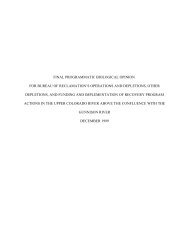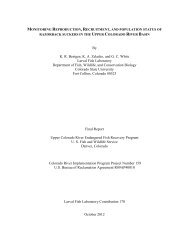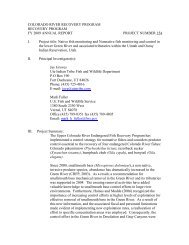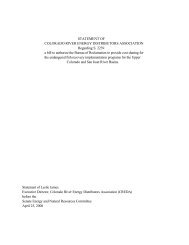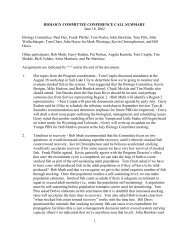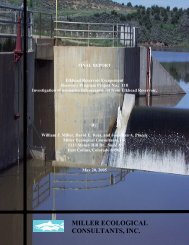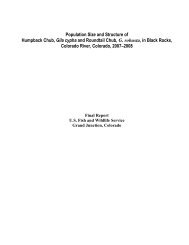riprap - Upper Colorado River Endangered Fish Recovery Program
riprap - Upper Colorado River Endangered Fish Recovery Program
riprap - Upper Colorado River Endangered Fish Recovery Program
Create successful ePaper yourself
Turn your PDF publications into a flip-book with our unique Google optimized e-Paper software.
I. BackgroundAgreementSection 7 Consultation, Sufficient Progress, and Historic Projects<strong>Recovery</strong> Implementation <strong>Program</strong> for the <strong>Endangered</strong> <strong>Fish</strong> Speciesin the <strong>Upper</strong> <strong>Colorado</strong> <strong>River</strong> BasinOctober 15, 1993Revised March 8, 2000The <strong>Recovery</strong> Implementation <strong>Program</strong> for <strong>Endangered</strong> <strong>Fish</strong> Species in the <strong>Upper</strong><strong>Colorado</strong> <strong>River</strong> Basin (RIP) is intended to go considerably beyond offsetting waterdepletion impacts by providing for the full recovery of the four endangered fishes. TheRIP participants recognize that timely progress toward recovery in accordance with a welldefinedaction plan is essential to the purposes of the RIP, including both the recovery ofthe endangered fishes and providing for water development to proceed in compliance withState law, Interstate Compacts, and the <strong>Endangered</strong> Species Act (ESA). <strong>Recovery</strong>activities which result in significant protection and improvement of the endangered fishpopulations and their habitat need to receive high priority in future planning, budgeting,and decision making. The RIP participants accept that certain positive populationresponses to RIP initiatives are not likely to be measurable for many years due to the timerequired for the endangered fishes to reach reproductive maturity, limited knowledge abouttheir life history and habitat requirements, sampling difficulties and limitations, and otherfactors. The RIP participants also recognize that further degradation of endangered fishhabitats and populations will make recovery increasingly difficult.II.RIP <strong>Recovery</strong> Action Plan (RIPRAP)The <strong>Recovery</strong> Action Plan (RIPRAP) identifies actions currently believed to be required torecover the endangered fishes in the most expeditious manner possible in the upper basin.It has been developed using the best information available and the recovery goalsestablished for the four endangered fish species. By reference, the RIPRAP is incorporatedand considered part of this agreement. The RIPRAP will be an adaptive management planbecause additional information, changing priorities, and the development of the States'entitlement may require modifications to the RIPRAP. The RIPRAP will be reviewedannually and modified or updated, if necessary, by September 30 of each year or prior toadoption of the annual work plan, whichever comes first. The RIPRAP will serve as aguide for all future planning, research, and recovery efforts, including the annual workplanningand budget decision process.The RIP is intended to provide the reasonable and prudent alternatives for projectsundergoing Section 7 consultation in the upper basin. While some recovery actions in theRIPRAP are expected to have more direct or immediate benefits for the endangered fishesthan others, all are considered necessary to accomplish the objectives of the RIP.<strong>Recovery</strong> actions which protect or improve habitat conditions and result in moreimmediate, positive population responses will be most important in determining the extentto which the RIP provides the reasonable and prudent alternatives for projects undergoingSection 7 consultation. In general, these actions will be given highest priority in theRIPRAP.1



